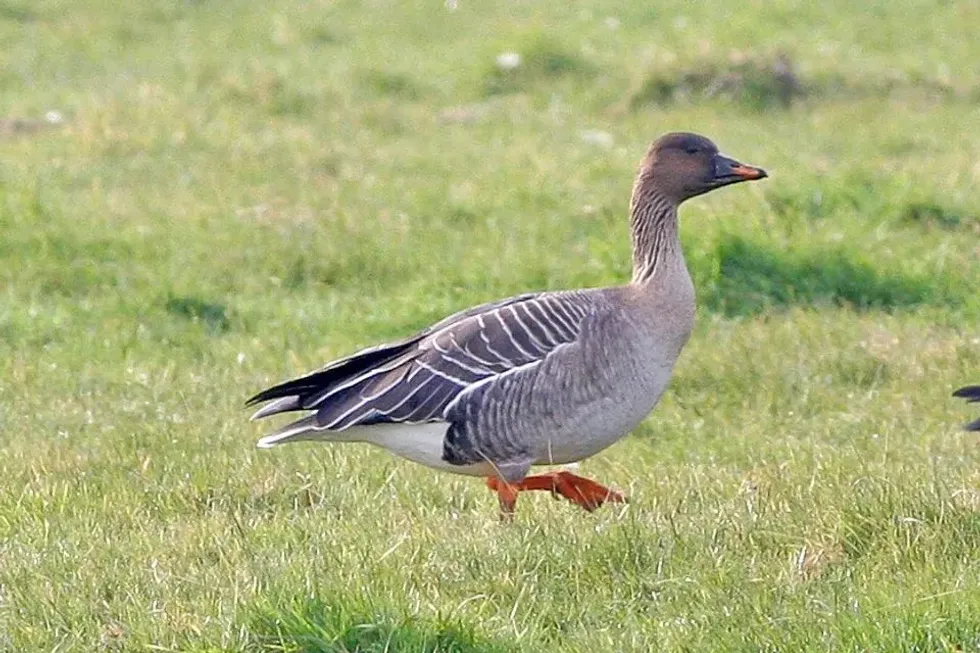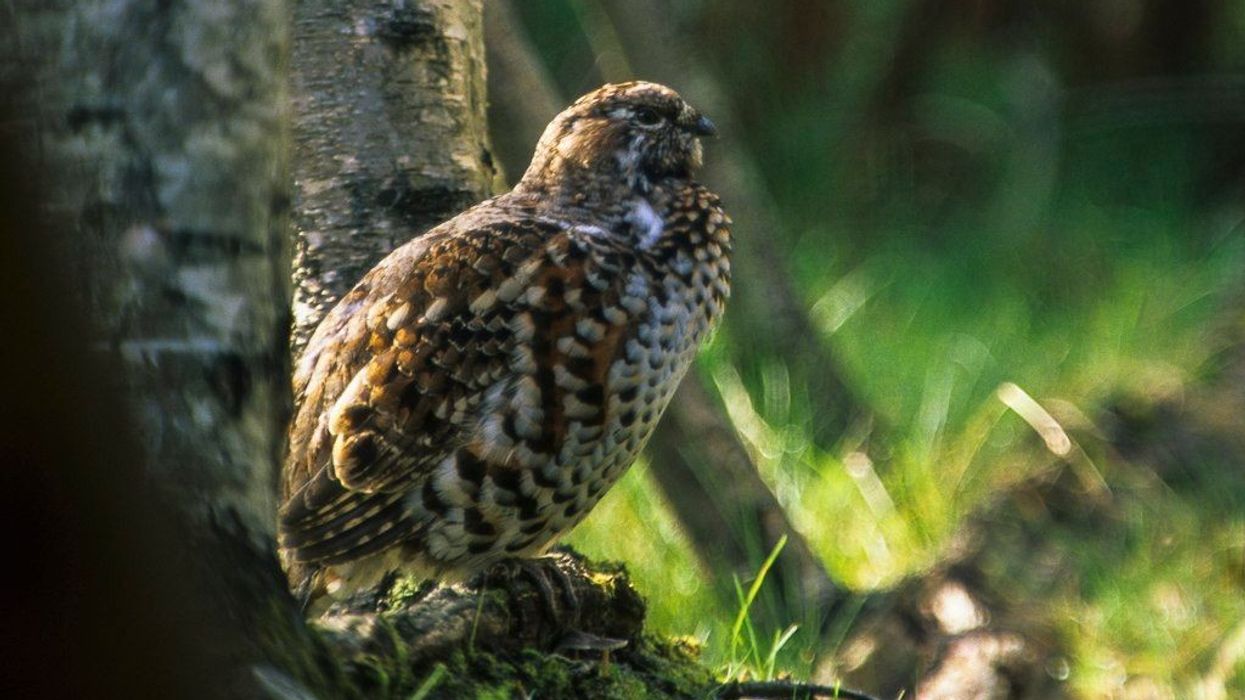A rare winter visitor to Britain, the tundra bean goose (Anser serrirostris) is from a family of gray geese. Despite common misconceptions, this species and the taiga bean goose (Anser fabalis) species are considered separate species. Organizations such as the American Ornithological Society and the International Ornithologists' Union recognize both as separate species.
Wintering flocks of the tundra bean goose are found in Yare Valley, Norfolk, and the Avon Valley in Scotland. In winter, the tundra bean goose is found in eastern China, central Asia, and western Europe.
Also, a vagrant population has also been witnessed in North America. Bean geese majorly inhabit marshes, wet grasslands, lakes, and large rivers in agricultural landscapes.
The average length and weight of this bird species are around 27–35 in (68-90 cm) and 3.7–8.8 lb (1.7–4 kg) and males generally weigh more than females. The tundra bean goose has a heavy body and a shorter neck.
Its bill is generally black at the base and the tip while an orange band can be seen on its middle. The legs and feet of the species are also bright orange in color.
Like the white-fronted goose (Anser albifrons) and the lesser white-fronted goose (Anser erythropus), this bird's upper-wing coverts are dark brown. The bean goose generally honks, while smaller subspecies possess a high-pitched voice.
The International Union for Conservation of Nature has not evaluated the status of this bird species as of now, while the taiga bean goose is listed as a species of Least Concern. Despite not being evaluated by the IUCN, the breeding range and population of the tundra bean goose are facing threats.
Threats such as habitat degradation, pollution, and the use of pesticides all majorly affect these bean geese.
For more relatable content, check out these goose facts and snow goose facts for kids.
Tundra Bean Goose Interesting Facts
What type of animal is a tundra bean goose?
The tundra bean goose (Anser serrirostris) is a migratory goose that has no regular wintering sites. Organizations such as the American Ornithological Society and the International Ornithologists' Union consider the taiga and tundra bean geese as distinct species.
A vagrant population of bean geese has also been found in a few regions of North America. The species was formerly considered as the subspecies of bean goose.
What class of animal does a tundra bean goose belong to?
The tundra bean goose (Anser serrirostris) belongs to the class of Aves, the family of Anatidae, and the genus Anser. Species such as the taiga bean goose (Anser fabalis) and the pink-footed goose (Anser brachyrhynchus) both belong to the Anser genus.
How many tundra bean geese are there in the world?
The current population of the tundra bean goose (Anser serrirostris) sits at around 600,000 individuals. meanwhile, there are around 53,000–57,000 taiga bean goose (Anser fabalis) birds currently. The population of the species seems to be stable and vagrant populations have also been found in various parts of North America.
Where does a tundra bean goose live?
Tundra bean geese have no regular wintering sites, but wintering flocks of taiga bean geese are found in Yare Valley, Norfolk, and the Avon Valley in Scotland. Also, in winter, the former species is found in several parts of Europe and Asia. A vagrant population has also been witnessed in North America.
What is a tundra bean goose's habitat?
The species generally dwells with other grey goose species such as the pink-footed goose and the taiga bean goose. Marshes, wet grasslands, lakes, and large rivers in agricultural landscapes are some of the main habitats of the species. The species also breeds in the tundra habitats of northern Eurasia.
Who do tundra bean goose live with?
Tundra bean geese are generally found in small flocks, and they also like to live with other goose species. The average flock size of the species remains at around 500 in Britain. Also, taiga bean geese become quite aggressive while defending their home territory. The species can also be found in pairs during the breeding season.
How long does a tundra bean goose live?
The exact life span of the tundra bean goose is not known as of now but the taiga bean goose lives for more than 25 years in the wild. Their life expectancy in captivity is not clear as these migratory birds generally die if kept in captivity, sadly.
How do they reproduce?
Very little is known about the reproduction patterns of the tundra bean goose. These birds generally breed in north Scandinavia, north Russia, and northern Asia. Also, their breeding population and range have declined in the last 20 years. It is said that these birds follow similar methods and patterns to other goose birds when it comes to reproduction.
This bean goose bird is monogamous and therefore it mates for life. These birds generally select their partners by the second winter of their life.
These birds perform several courtship displays; the most common displays are a flight of three to four birds together or a display of their tail feathers while swimming. These birds also perform a 'triumph ceremony' when a mate is chosen. To strengthen the family bond, this ceremony can be performed every year.
This bean goose bird generally breeds yearly and both partners raise the young goose. These birds become sexually mature after three years, and the average litter size of this bean goose is around four to five. Their incubation period lasts for no more than 29 days.
What is their conservation status?
The International Union for Conservation of Nature has not evaluated the status of these geese as their population seems to be stable as of now. Studies reveal that there are around 600,000 of these geese as of now.
Also, taiga bean geese are listed in the Least Concern category in the IUCN Red List. Despite this, the population and breeding range of all bean geese can be affected by threats such as habitat degradation, pollution, and the use of pesticides.
Tundra Bean Goose Fun Facts
What do tundra bean goose look like?
The tundra bean goose is a gray goose bird; the species has a heavy body and possesses a shorter neck. The bill of this bird is black at the base while an orange band can be seen in the middle, and the legs and feet of the species are also bright orange in color.
Their upper-wings coverts are dark brown. Their heavy and stockier build resembles the Anser fabalis rossicus bird and males are generally bigger than females.
How cute are they?
These bean geese are the highest flying birds in the world and these large waterfowls generally fly in a 'V' shape that looks fascinating! These birds, like many domestic dogs, can even bond with humans and their goslings are also super cute.
How do they communicate?
Very little is known about the communication methods of these geese, but the species generally uses similar methods to the taiga bean goose. These birds possess loud calls and generally squeal when communicating with others.
An 'unk unk' sound is quite common as well. Due to human disturbances, some of these bean geese have turned nocturnal.
Also, the tundra bean goose performs multiple courtship displays during the breeding season. These common displays are a flight of three or four birds together, a display of tail feathers while swimming, and many more.
How big is a tundra bean goose?
The average length and weight of this bird species are around 27–35 in (68-90 cm) and 3.7–8.8 lb (1.7–4 kg) and males generally weigh more than females. The tundra bean goose is three times bigger than the African pygmy goose while some are twice the size of the nene goose.
Species such as the pink-footed goose are quite a bit smaller than the tundra bean goose.
How fast can a tundra bean goose fly?
The exact speed of the tundra bean goose is not known as of now but a few similar species (such as the spur-winged goose) can achieve a speed of around 88.2 mph (141.94 kph) in flight!
These birds form flocks during flight and generally fly thousands of miles every day, some of them even fly to Britain and North America from Europe and Asia in winter.
How much does a tundra bean goose weigh?
The average weight of a tundra bean goose is around 3.7–8.8 lb (1.7–4 kg).
What are their male and female names of the species?
Terms such as gander and dame are used to refer to a male and a female bean goose. Also, it is quite hard to determine the sex of this bird due to the similarity in the appearance of males and females.
What would you call a baby tundra bean goose?
The babies of tundra bean geese are known as goslings.
What do they eat?
These birds are herbivores and they generally feed on grasses, seeds, barley, rice, soybeans, wheat, potatoes, and sugar beets. Some geese species are omnivores and they prey on insects and fish. Also, these tundra bean geese are preyed upon by hawks and Arctic foxes.
Are they dangerous?
Like other goose species, the tundra bean goose is not considered a dangerous bird but it can attack if someone tries to threaten the bird. Also, the bird possesses a thick bill and so attack from this bird can cause severe injuries.
Species such as the taiga bean goose are quite aggressive and they are generally violent when a person or animal approaches its territory.
Would they make a good pet?
As the tundra bean goose is a migratory bird that changes its territory in winter, people generally don't consider the species as an ideal pet. Also, the loud noise and the calls of these birds can annoy humans!
Did you know...
Anser serrirostris rossicus and Anser serrirostris serrirostris are two subspecies of the tundra bean goose. The former species is generally smaller in size, has a short bill, and has narrow orange bands.
The average wingspan of the species is around 55–69 in (140-174 cm).
How many eggs do tundra bean goose lay?
The female tundra bean goose generally lays between four and five eggs. These birds generally breed in several Asian countries and European countries such as Serbia, Norway, and Denmark. Both parents are involved in raising goslings (young geese) as males generally defend the territory whilst females feed the young geese.
How to spot tundra bean goose?
Like other species of the Anser genus, the tundra bean goose is generally gray in color but several distinct body features can help you to differentiate them from other geese breeds. Unlike other geese species, these birds are a bit darker and browner.
The species possesses dark brown upper wing coverts with narrow white stripes to the plumage. Their feet and legs are orange in color while the belly is completely white.
Here at Kidadl, we have carefully created lots of interesting family-friendly animal facts for everyone to discover! Learn more about some other birds from our swan goose facts and common ground dove facts pages.
You can even occupy yourself at home by coloring in one of our free printable goose coloring pages.









